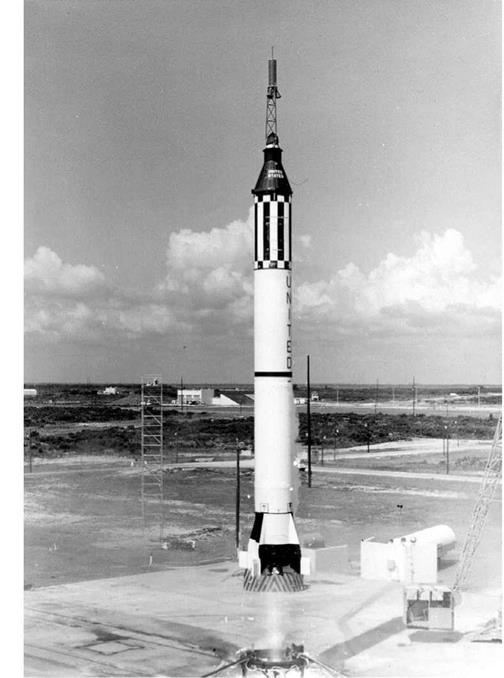Flight Log
The first of what were originally to be seven manned sub-orbital Mercury flights, then reduced to three, could have taken place in March 1961, before Gagarin, had the programme not hit technical problems. Al Shepard decided to name his spacecraft Freedom. Adding the number seven to the name became too irresistible, as the capsule and rocket were both serial number seven and there were seven astronauts. This established a precedent for later manned flights. Shepard simulated the flight inside Freedom on Cape Canaveral’s Pad 5 three times before the first launch attempt on 2 May was thwarted by bad weather.
On 5 May, the astronaut was up at 01: 10 hours and inside Freedom 7 at 05: 20 hours. Compelled to urinate in his spacesuit because of the unforeseen 2 hr 34 min launch holds, the laconic Shepard finally got airborne at 09: 34 hours, uttering the first of 78 statements, practised so many times in the simulator, announcing lift-off. His heartbeat was monitored at 126 beats per min. The period of maximum dynamic pressure reached at T + 58 sec buffeted the vehicle and caused some concern. The launch escape system tower separated at T + 2 min 32 sec, as Shepard was experiencing a maximum 6.3 G force. The Redstone shut down at T + 142 sec and Shepard arced even higher over the Atlantic Ocean, at a maximum speed of 8,262 kph (5,134 mph), reaching a maximum altitude of 185.6 km (115.3 miles).
During his 4 min 45 sec period of weightlessness, Shepard fired his thrusters to orientate the spacecraft in yaw, pitch and roll movements for a period of 40 sec. He only saw the Earth as black and white out of his periscope and not the porthole, and then he moved the craft to a nose down angle of 34° before firing the retros, although they were not needed during this sub-orbital flight. The descent was uneventful, the 0.5 G light coming on at 60,960 m (200,000 ft) and with Shepard enduring 11 G deceleration. The
![]()

|
drogue chute deployed at 6,400m (21,000 ft) and the main chute at 3,048 m (10,000 ft). Freedom hit the sea at a speed of 10.7m/sec (35.1 ft/sec), 475.2 km (295miles) down – range from the Cape at T + 15 min 28 sec, the shortest manned space flight in history. Shepard removed the hatch and was hauled aboard a helicopter from the recovery ship Lake Champlain.
Milestones
2nd manned space flight
1st US manned space flight
1st to make orientation manoeuvres
1st flight to splashdown in the sea
1st flight to end with the crew aboard
MERCURY REDSTONE 4
 None – sub-orbital flight 21 July 1961
None – sub-orbital flight 21 July 1961
Pad 5, Cape Canaveral, Florida 21 July 1961 Atlantic Ocean
Redstone No. 8; capsule no. 11 15 min 37 sec Liberty Bell 7
Second sub-orbital test of Mercury spacecraft with a human occupant, further system qualification towards manned orbital missions
Flight Crew
GRISSOM, Virgil Ivan “Gus”, 35, USAF, pilot










